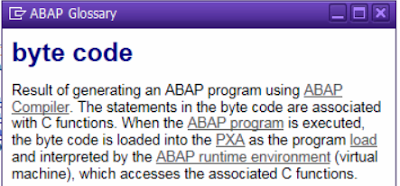I use this small blog to help my new colleagues on board who have Java programming background to understand the hello world example written in ABAP.
The following example could be done in pure text editor without Java IDE. You should have JDK installed as prerequisite and corresponding environment variable setup correctly.
Once done, type javac -version in command line, you should see the following output: ( result may vary based on your JDK version )
Hello World example in Java
The following example could be done in pure text editor without Java IDE. You should have JDK installed as prerequisite and corresponding environment variable setup correctly.
Once done, type javac -version in command line, you should see the following output: ( result may vary based on your JDK version )
In my laptop the javac.exe is in this folder:
1. Create a folder in c:\temp\testPackage.
2. Create a file HelloWorld.java in text editor with source code below:
package testPackage;
import tool.Tools;
public class HelloWorld {
public HelloWorld() {
}
static public void main(String[] arg){
System.out.println("Hello World");
Tools.Print();
}
}
Create another folder in C:\temp\tool.
And another Tools.java:
package tool;
public class Tools{
static public void Print(){
System.out.println("I am tool!");
}
}
This example shows that the HelloWorld class has dependency on Tools class.
1. Now compile HelloWorld class via javac:
Once done, HelloWorld.class is generated:
Also the same for Tools.class, even though we do NOT manually compile Tools.java via javac.
2. Now make some change on Tools.java:
And execute HelloWorld, still the old string before change is printed:
3. Compile Tools.java again, new version of Tools.class is generated.
This time execute HelloWorld and you could observe the new string printed out.
And the byte code for HelloWorld is still unchanged.
Byte Code in ABAP – ABAP Load
The following texts are copied from ABAP help:
Result of generating an ABAP program using ABAP Compiler. The statements in the byte code are associated with C functions. When the ABAP program is executed, the byte code is loaded into the PXA as the program load and interpreted by the ABAP runtime environment (virtual machine), which accesses the associated C functions.
Let’s repeat the same test in ABAP.
1. Create a new include ZTOOL and activate it:
form print.
WRITE: / 'Hello World.'.
endform.
And create a new HelloWorld report and activate it as well.
REPORT ZHELLOWORLD.
INCLUDE ztool.
START-OF-SELECTION.
PERFORM print.
2. Execute report RSDEPEND to analyze the dependency of report ZHELLOWORLD.
The result shows that ZHELLOWORLD has dependency on ZTOOL. The timestamp of ZHELLOWORLD is larger than ZTOOL since it is activated later than ZHELLOWORLD.
3. Make some changes on ZHELLOWORLD, for example add one line comment and activate it again. This time the timestamp of ZHELLOWORLD changes, however ZTOOL remains unchanged.
4. Now make changes on ZTOOL, activate the change. Don’t touch ZHELLOWORLD.
This time the timestamp of ZHELLOWORLD is also changed which equals exactly to the change timestamp of ZTOOL.
The generated ABAP load for a given report could be found from table REPOLOAD:













good blog,thank you for sharing information sap abap online training in hyderabad
ReplyDelete